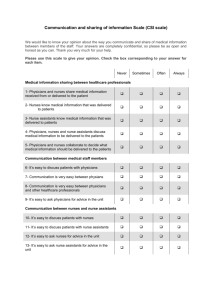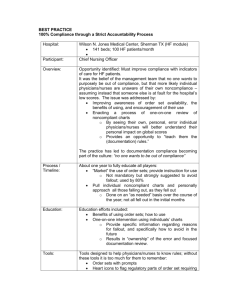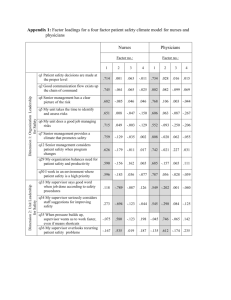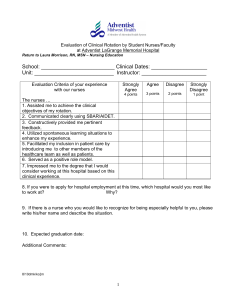Document 13898402
advertisement
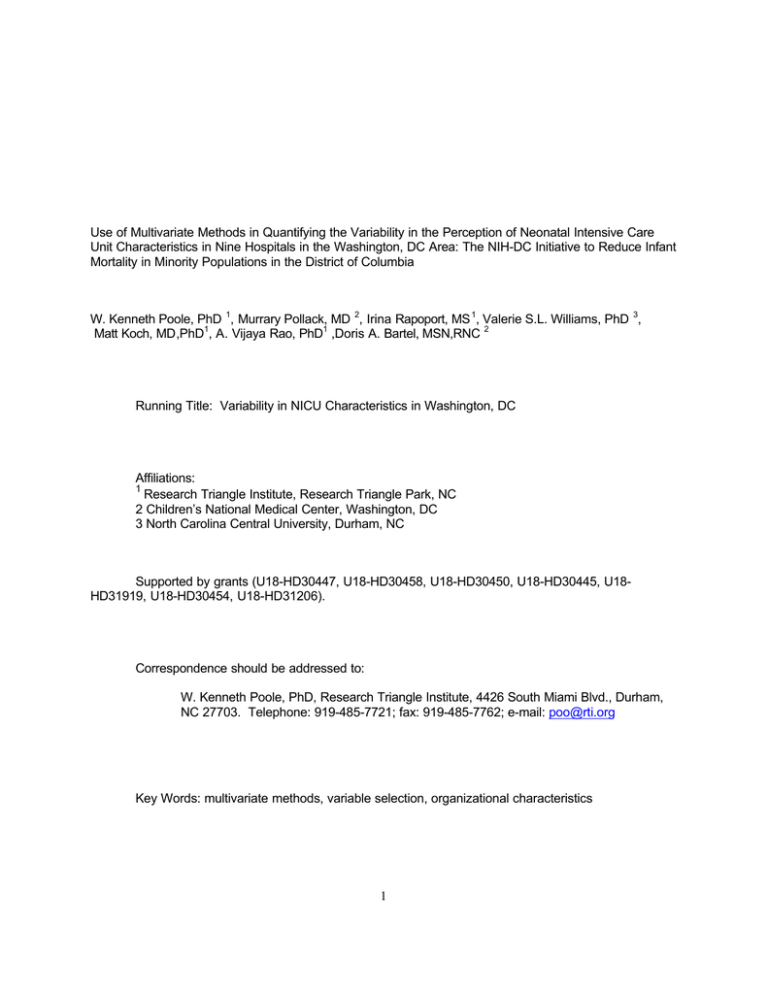
Use of Multivariate Methods in Quantifying the Variability in the Perception of Neonatal Intensive Care Unit Characteristics in Nine Hospitals in the Washington, DC Area: The NIH-DC Initiative to Reduce Infant Mortality in Minority Populations in the District of Columbia W. Kenneth Poole, PhD 1, Murrary Pollack, MD 2, Irina Rapoport, MS 1, Valerie S.L. Williams, PhD 3, Matt Koch, MD,PhD1, A. Vijaya Rao, PhD1 ,Doris A. Bartel, MSN,RNC 2 Running Title: Variability in NICU Characteristics in Washington, DC Affiliations: 1 Research Triangle Institute, Research Triangle Park, NC 2 Children’s National Medical Center, Washington, DC 3 North Carolina Central University, Durham, NC Supported by grants (U18-HD30447, U18-HD30458, U18-HD30450, U18-HD30445, U18HD31919, U18-HD30454, U18-HD31206). Correspondence should be addressed to: W. Kenneth Poole, PhD, Research Triangle Institute, 4426 South Miami Blvd., Durham, NC 27703. Telephone: 919-485-7721; fax: 919-485-7762; e-mail: poo@rti.org Key Words: multivariate methods, variable selection, organizational characteristics 1 Abstract In assessing the relationship between organizational characteristics of health care facilities and patient outcomes, standard questionnaires about the organizational components are often administered to health care facility staff and the results from the questionnaires are then related to the outcomes. The questionnaires used in these studies have often been developed and tested in populations somewhat different from the study populations. Hence, there may be considerable noise in the instruments as they relate to the study participants. In this paper we consider such a situation when we look at the organizational characteristics of nine neonatal intensive care units (NICUs) in the Washington, DC area. The ultimate objective of the study was to look at the relationship between organizational characteristics and neonatal morbidity and mortality. However, in preparation for this an investigation was made of the organizational characteristics data generated from a standard instrument developed for adult intensive care units by Shortell. The goal of this preliminary investigation was to screen out items (questions) that did not discriminate among hospitals and to develop optimal linear composite scores of the discriminating items to be used in the morbidity and mortality analyses. Tailored versions of the Shortell instrument were administered to 241 Nurses, 78 Physicians and 85 Respiratory Therapists (RTs) at the nine Washington, DC hospitals. The instrument contained 109 items making up 29 scales and 7 constructs. Using a multivariate selection process: 66 items, 12 scales and 2 constructs were eliminated for nurses; 96 items, 21 scales and 3 constructs for Physicians; and 98 items, 21 scales and 2 constructs for RTs. The final composite of scales was a measure that had canonical correlations of .77, .81 and .77 with hospitals for Nurses, Physicians and RTs, respectively. 2 Background The NIH-DC Initiative to Reduce Infant Mortality in Minority Populations in the District of Columbia is a cooperative agreement in the District of Columbia tasked with identifying the determinants of high levels of infant mortality in minority populations. One of the protocols implemented in this cooperative agreement is entitled “The Association of Neonatal Outcomes with the Characteristics of Neonatal Units.” This protocol presents a plan for studying the relationship between characteristics of neonatal intensive care units (NICUs) and neonatal outcomes. One of the primary goals of this study is to identify NICU management characteristics, as reported by nurses, physicians and respiratory therapists, which are predictive of risk adjusted mortality and morbidity thereby identifying the most effective current practices in the NICUs of District of Columbia hospitals. This study is of national importance for once identified, these characteristics and care patterns could then be disseminated to the medical community to promote the best care structure for NICUs in similar communities in other parts of the country. This study was funded by the NIH Office of Research on Minority Health and the NIH National Institute of Child Health and Human Development. The literature is replete with studies of care characteristics that are associated with outcomes. These include: the volume of patients treated by hospitals and/or practitioners [Hannan (1989), Luft (1980), Williams (1991)]; care giver characteristics [Burns (1991), Kelly (1986)]; the health facility size [Keeler (1992)]; the organization and coordination of care [Knaus (1986), Pollack (1991)]; the urban/rural location of the hospital [Keeler (1992)]; the teaching status of the hospital [Keeler (1992), Brennan (1991), Hartz (1989)]; the availability of specialized facilities for patient care [Pollack (1991)]; and the ownership status of the hospital [Hartz (1989)]. Hospital characteristics associated with better outcomes for one type of patient or disease are not necessarily associated with better outcomes for other types of patients or diseases. For example, the surgical volume of the hospital and/or surgeon may be important for some operations but not others [Hannan (1989)]. A recent study of pediatric intensive care units (PICUs) also supports this conclusion [Pollack (submitted)]; characteristics positively associated with improved outcomes from the general hospital population were negatively associated with outcomes from PICUs. Traditionally, research has focused on the classic quality triad of structure-process-outcome. Although health care practitioners generally believe that organizational structures and processes can influence patient outcomes such as mortality, the evidence for such relationships is, at best, inconsistent [Mitchell (1997)]. Research, however, has only recently begun to investigate elements from organizational theory and organizational behavior including collaboration, leadership, climate, bureaucracy, practice models, and job satisfaction [Baggs (1992), Mitchell (1996), Aiken (1994), Cassard (1994), Mitchell (1989)]. Within the context of this study, the theoretical framework for the belief that structure and process may influence outcome includes the following [Mitchell (1997)]: 1) organizational structures and processes can help insure an experienced and thus more qualified staff since they are related to job satisfaction and increased retention; 2) collaboration as evidenced by the interdisciplinary sharing of time, expertise, and resources is a crucial link between patient care and organizational structures and processes. The lack of a demonstrated effect of structure and process on major outcomes may be due to imprecision in the measurement instruments when applied to the population under study. For example, if an instrument has been developed and tested in one population and is subsequently used in a different 3 population then certain elements of the instrument may no longer be relevant and may simply add noise to the data and the analytic results. To overcome this difficulty one has to develop ways of filtering out the noise or increase the sample size to compensate for the increased variability. In this study we have chosen the former approach and this paper describes the methodology for doing so. The purpose of this paper is to study the management practices and perceptions in nine Washington DC NICUs as measured by the Shortell instrument [Shortell (1991)]. This instrument was first developed and validated with the use of data from 1700 respondents (Physicians and Nurses) from 42 intensive care units around the country [Shortell (1991)]. This paper will assess the degree to which the Shortell items and scales differentiate among the nine DC NICUs and will determine weighted composites of items and scales which maximally discriminate among the NICUs. The weighted composites will be used in a future publication in relating NICU characteristics to infant outcomes in the nine hospitals surveyed. Materials and Methods Data The protocol for The Association of Neonatal Outcomes with Care Characterictics of Neonatal Units hypothesized that infant outcomes are related to risk adjusted characteristics of NICUs. A retrospective cohort of 235 infants and a prospective cohort of 312 infants have been enrolled in the study from nine area hospitals: Providence Hospital; Washington Hospital Center; Children’s National Medical Center; Howard University Hospital; Georgetown University Hospital; Columbia Hospital for Women; George Washington University Hospital; DC General Hospital and Hospital for Sick Children. One component of this study involved data collection from a special survey of Physicians, Nurses, and Respiratory Therapists working in the NICUs of these hospitals. The Shortell instrument was administered to 241 Nurses, 78 Physicians, and 85 Respiratory Therapists. The questionnaires were delivered individually to NICU staff members and were mailed back to the Data Coordinating Center at Research Triangle Institute in Research Triangle Park, North Carolina.. Anonymity of staff and hospital was assured. These data are the basis for illustration of the methodology discussed in this paper. The Instrument The original Shortell instrument sought to assess staff perceptions of organizational and managerial characteristics by utilizing twenty nine scales divided into seven constructs. These constructs are defined in [Shortell (1991)] as: Unit Culture “constitutes the norms, values, beliefs, and expectations shared by people who work in a given unit”; Leadership reflects “the capacity of individuals to influence others toward the accomplishment of organizationally relevant goals/objectives”; 4 Communication is “measured along a number of dimensions including openness, accuracy, timeliness, understanding and satisfaction”; Coordination is “the degree to which work activities are coordinated within the Nursing and Physician groups and between the two groups within the unit”; Problem Solving/Conflict Management distinguishes between “four different approaches to problem solving and conflict resolution,” including: 1) open, collaborative problem-solving approaches, 2) arbitration approaches, 3) avoidance, and 4) forcing; Unit Cohesiveness “involves the degree to which people identify with the work unit”; Unit Effectiveness has “three ‘outcome’ measures of effectiveness examined as criterion tests of validity. The first involves Nurse and Physician perceptions of absolute technical quality of care provided in the unit. The second involves their judgment of the ability of the unit to meet family member needs, and the third involves the use of data on Nursing turnover in the unit.” The version of the Shortell instrument used in this study was a shorter version of the original instrument that was developed by its authors and composed of 109 items. The shorter version used in this study eliminated the constructs measuring Unit Culture and Unit Cohesiveness, used only a subset of the original scales to assess the constructs for Coordination, Communication, and Conflict Management, and added new questions measuring Authority and Job Satisfaction constructs. The instrument was originally developed for nurses and physicians, and consisted of parallel questions for each professional group. For example, questions about leadership for nurses referred to nursing leadership and leadership questions for physicians were identical except they referred to physician leadership. The instrument was modified for this study to be applicable to Respiratory Therapists (RTs) as well. This modification consisted of adding parallel questions for RTs to the questions already existing for Physicians and Nurses. Hence, each of the three professional groups (nurses, physicians and RTs) had their own parallel version of the instrument. Each professional responded to questions about their own group as well as questions about the other two groups. The constructs and scales for the modified instrument are given in Table 1. Data Analysis The analyses were formulated to address two related issues: scale refinement and selection of that set of scales which accounts for the most variation among the nine hospitals. For this refinement and selection we chose a variation of a multivariate selection procedure introduced by Rao [Rao (1965)]. He proposed this method as a way of testing whether a subset of components of a vector in a multivariate test accounts for the statistical significance of the multivariate test. In our modification, this procedure performs a multivariate analysis of variance which tests the equality of vectors (here, items or scales) across comparison groups (hospitals) and successively moves components from the dependent variable vector into covariate positions until the multivariate significance has vanished or the components have 5 been exhausted. We chose a liberal p-value of .10 for this screening in order to guard against eliminating items and scales which may have been retained with a larger sample size. The same procedure was used for scale refinement and scale selection for each professional group separately (RTS, Nurses, and Physicians). Hence, there was no attempt to force the selection process to select the same items and scales for the three professional groups. A by-product of the selection process was a determination of the linear combination of the different items (scales) which maximized the variation among the hospitals. It should be emphasized that this selection procedure in no way depends on outcome variables which were later studied with respect to their relationship with the organizational characteristic scales. The selection and optimal weighting strategy may be summarized in the following schema for each professional group: Select Items Optimally Weight Select Scales Optimally Weight Within Scales⇒Selected Items to Form⇒to Form Composite⇒Selected Scales to Form Scales Score Composite Score Scale refinement We refined scales by first conducting separate Multivariate Analysis of Variance (MANOVA) tests for each set of items (questions) of each section of the questionnaire to test the hypothesis of no difference in the vector of item means across the nine hospitals. The refinement process was done in stages as follows: Stage 1 model for items: ( item1, item2, ..., itemk ) = hospital sites where k is the number of items in the set from the Shortell scale assessing a single subconstruct. If the multivariate test statistic was significant (p < .10), we examined for each item the univariate Analysis of Variance (ANOVA) for testing the hypothesis of no difference in item means across the nine hospitals. That item, say item i, with the largest univariate F was moved to the right side of the equation and led to the second stage: Stage 2 model for items: ( item1, ..., itemi-1, itemi+1, ..., itemk ) = hospital sites, itemi Items within the same construct are highly correlated; therefore, using itemi as a covariate reduces the variability of the error term in the multivariate and univariate ANOVAs. If Stage 2 results in a statistically significant multivariate statistic, the item on the left side of the model equation with the largest univariate F was moved to the right side of the equation as another covariate for further analyses. This process is repeated until the multivariate test is no longer statistically significant (i.e. p>.10) or the items have been exhausted. If m items are selected then at Stage m+1, a MANOVA was used to model the relation between the final subset of m selected items (as the dependent variables) and the nine hospitals: 6 Stage (m+1) model for items: ( item1, item2, ..., itemm ) = hospital sites . The first principal component of the E-1 H matrix, the matrix from which the multivariate test of hospital differences is constructed, gives that linear combination of the m items which maximizes the variation across hospital sites. This defines the scale of interest such that each item in the final subset contributes independent increments to the total variation and is optimally weighted. We also determined in a similar manner which scales (i.e., linear combinations of items) account for the most unique variation among hospitals. For each professional group and construct separately, we reduced the number of scales by performing a series of MANOVAs as described above in order to select that set of scales which is most highly discriminating with respect to the nine hospitals. The procedure is the same as that described above for selecting the final subset of items. For example: Stage 1 model for scales: ( scale1, scale2, ..., scalep ) = hospital sites where p is the number of scales analyzed. In the presence of a significant multivariate test (p < .10), that scale with the largest univariate F, say sca le i , was moved to the right side of the equation, and the new model was re-estimated: Stage 2 model for scales: ( scale1, scale2, ..., scalei-1, scale i+1, ..., scalep) = hospital sites, scalei This produced the linear combination of the remaining set of scales which is most highly discriminating with respect to the nine hospitals, effectively adjusting for the covariance associated with the scale identified in Stage 1. The process terminates when the multivariate test is no longer statistically significant or the scales have been exhausted, providing us with the final set of scales that explains the most unique variation among hospitals. Results Table 2 contains the descriptive statistics for the unselected, unweighted scales and constructs using Shortell’s scoring procedure of simply summing the component items. The scores for negatively worded items were reflected so that larger scores corresponded to positive attitudes for all items. The values are in the units of the Likert scale (i.e., ranging from 1 to 5) and indicate that for most scales each of the groups, on average, responded slightly above the apparent midpoint of 3. Also of interest is the fact that for most scales based on the raw data, the Physicians scored the highest of the three professional groups, the Nurses scored second highest, and the RTs scored the lowest. 7 Multivariate Analysis of Items Tables 3, 4, and 5 contain all scales surviving the first stage of the multivariate analyses, that is, those scales that include at least one item (i.e. question) that differs across hospitals. For Nurses (Table 3), 27 of the original 29 scales were retained after the first stage screening of items, but 11 of these became single-item scales. For Physicians (Table 4), 17 scales were retained (13 are single-item scales). In the case of Respiratory Therapists (Table 5), 14 scales were retained, 10 of which were comprised of only one item. Optimal weights from the item analysis MANOVAs were applied to the items of multi-item scales to form the scales for scale selection. Multivariate Analysis of Scales Seventeen Nurses scales were selected in the second stage of the MANOVA (shown in Table 3 in bold italics), and eight scales each for both Physicians and Respiratory Therapists (shown in Tables 4 and 5 in bold italics). In the last columns of Tables 3, 4, and 5, the percent of variation in each weighted scale due to Hospital effect (R2s) is displayed. For example, 23.7% of the variation in the three-item “Timeliness” scale (i.e. the optimally weighted linear combination of the three items) for Nurses is accounted for by hospital-to-hospital variation. Hospitals account for 35.3%of the variation in the five-item “Absolute Technical Quality” scale for Nurses. The next to the last column in Tables 3, 4, and 5 gives the percent of the total variance of the items in the scale accounted for by the optimum linear combination. All multiitem scales account for at least 50% of the total variation in the scale items; all single item scales, of course, account for 100%. Also of interest is the proportion of variation in the entire set of scales explained by Hospitals. In the context of a one-way MANOVA, a canonical analysis of the scales and Hospitals produces a first canonical correlation which maximizes the relation between the optimal linear combinations of two sets of variables. In this case, the canonical correlation describes the relation between Hospitals and the entire set of scales for each professional group. For Nurses, the first canonical correlation between Hospitals and the final set of 17scales is .772; the R2 is .595 indicating that nearly 60% of the variation in the scales is accounted for by hospital variation. The first canonical correlation for Physicians is similar at .809 (R2=.655), and for Respiratory Therapists, .768 (R2 = .591). The final analysis of the scales and constructs consisted of the derivation of a composite construct measuring Nurse, Physician, and RT perception of the organization and management of the NICU in which they worked. This composite is that linear combination of the scales which survived the item and scale screening that best discriminate among the nine hospitals. Per person averages of these composites are displayed for each professional group by hospital combination in Table 6 and Figure 1. The composites have been scaled to the original range(i.e. 1 to 5). For comparison purposes we have also included Figure 2 which shows the per person averages of the item averages prior to the multivariate selection and differential weighting. Clearly the selection and refinement procedures have resulted in measures that exhibit more variability across hospitals than do the unweighted averages. 8 Discussion In this paper we have presented a method of modifying the Shortell scales and composites of the scales to maximize the discrimination among neonatal intensive care units in nine Washington, DC hospitals. In order to eliminate nondiscriminating questionnaire items, scales (groups of questions) and constructs (groups of scales), and to form optimal linear combinations of items, scales, and constructs, we used a multivariate selection and weighting procedure. This method first eliminated items from scales which did not show independent variation across hospitals, and then optimally weighted the retained items to form scale scores. The procedure then eliminated scale scores which did not show independent variation across hospitals and optimally weighted the retained scale scores to form construct scores. Finally, it weighted construct scores to form a composite score for each hospital by professional group combination (27 values in all). From an original set of 109 items, 29 scales and 7 constructs for each professional group, this screening and compositing procedure resulted in eliminating: 66 items, 12 scales and 2 constructs for Nurses; 96 items, 21 scales and 3 constructs for Physicians; and 98 items, 21 scales and 2 constructs for RTs. The final best single composite of these scales for the three professional groups(Table 6 and Figure 1) resulted in a measure which was highly correlated with hospital site (canonical correlations .77, .81, and .77 for Nurses, Physicians, and RTS, respectively). These analyses suggest that a tailored version of the Shortell scales may be useful in quantifying the perceptions by Nurses, Physicians, and RTs of management and operations in hospital NICUs. This tailoring is justified by the fact that the Shortell scales were developed from a study of adults and previous studies have shown that measurement instruments developed in one population are not necessarily transferable directly to a different population. 9 REFERENCES Aiken LH, Smith HL, Lake ET. (1994) Lower Medicare mortality among a set of hospitals known for good nursing care. Med Care; 32:771-787. Baggs JG, Ryan SA, Phelps CE, Richeson JF, Johnson JE. (1992) The association between interdisciplinary collaboration and patients outcomes in medical intensive care. Heart Lung:21:18-24. Brennan TA, Hebert LE, Laird NM et al. (1991) Hospital characteristics associated with adverse events and substandard care. JAMA; 265:3265-9. Burns LR, Wholey DR. (1991) The effects of patient, hospital, and physician characteristics on length and stay and mortality. Med Care; 29:251-71. Cassard SD, Weisman DJ, Gordon DL, Wong R. (1994) The impact of unitbased self-management by nurses on patient outcomes. Health Serv Res;29:415-33. Hannan El, O’Donnell JF, Bernard HR et al. (1989) Investigation of the relationship between volume and mortality for surgical procedures performed in New York State hospitals. JAMA; 262:503-10. Hartz AJ, Krakuer H, Kuhn EM et al. (1989) Hospital characteristics and mortality rates New Engl J Med; 321:1720-5. Keeler EB, Rubenstein LV, Kahn KL et al. (1992) Hospital characteristics and quality of care. JAMA; 268:1709-14. Kelly JV, Hellinger FJ. (1986) Physician and hospital factors associated with mortality of surgical patients. Med Care; 24:785-800. Knaus WA, Draper EA, Wagner DP et al. (1986) An evaluation of outcome from intensive care in major medical centers. Ann Intern Med; 104:410-8. Luft HS. (1980) The relationship between surgical volume and mortality: an exploration of causal factors and alternative models. Med Care; 18:940-59. 10 Mitchell PH, Armstrong S, Simpson TF. (1989) American association of critical care nurses demonstration project: profile of excellence in critical care nursing. Heart Lung;18:219-37. Mitchell PH, Shannon SE, Cain KC, Hegyvary ST. (1996) Critical care outcomes: linking structures, processes, and organizational and clinical outcomes. Am J Crit Care;5:553-563. Mitchell PH, Shortell SM. (1997) Adverse outcomes and variations in organization of care delivery. Med Care:; 35:NS19-NS32. Pollack MM, Alexander SR, Clarke N et al. (1991) Improved outcomes from tertiary center, pediatric intensive care: a statewide comparison of tertiary and nontertiary care facilities. Crit Care Med; 19:150-59. Pollack MM, Cuerdon TC, Patel KM et al. Pediatric intensive care mortality: the effect of size, teaching, intensivists, and care coordination. Submitted. Rao CR, (1965) Linear Statistical Inference and Its Application, John Wiley and Sons, Inc., New York Shortell SM, Rousseau DM, Gillies RR, Devers KJ, Simons TL. (1991) Organizational assessment in intensive care units (ICUs): construct development, reliability, and validity of the ICU nurse-physician questionnaire. Med Care; 29:70926. Williams SV, Nash DB, Goldfarb N. (1991) Differences in mortality from coronary artery bypass graft surgery at five teaching hospitals. JAMA; 226:810-5. 11 TABLE 1 CONSTRUCTS AND SCALES OF THE SHORTELL INSTRUMENT USED TO QUANTIFY THE ORGANIZATIONAL CHARACTERISTICS OF NICUS I. Team Work and Leadership Nursing Leadership The degree to which Nursing leadership sets and communicates clear goals and expectations, and is responsive to changing needs and situations. Physician Leadership The degree to which Physician leadership sets and communicates clear goals and expectations, and is responsive to changing needs and situations. RT Leadership The degree to which RT leadership sets and communicates clear goals and expectations, and is responsive to changing needs and situations. II. Relationships and Communications Within the NICU Within-group Communication Openness The degree to which Physicians, Nurses or Respiratory Therapists (RTS) are able to “say what they mean” when speaking with others of their own kind without fear of repercussions or misunderstanding. 12 Between-group Communication Openness The degree to which Physicians, Nurses or RTS are able to “say what they mean” when speaking with members of the other groups, without fear of repercussions or misunderstandings. Within-group Communication Accuracy The degree to which Nurses (Physicians, RTS) believe in the consistent accuracy of the information conveyed to them by others of their own kind. Between-group Communication Accuracy The degree to which Nurses (Physicians, RTS) believe in the consistent accuracy of the information conveyed to them by members of other groups. Communication Timeliness The degree to which patient care information is relayed promptly to the people who need to be informed. III. Coordination The degree to which relationships with other units in the hospital facilitate ICU performance. IV. Perceived Unit/Team Effectiveness Perceived Effectiveness at Recruiting and Retaining Nurses (Physicians, RTS) The degree to which the unit is perceived as recruiting and retaining excellent Nurses (Physicians, RTS). Absolute Technical Quality of Care The perceived effectiveness of the unit with regard to patient care needs and outcomes. Perceived Effectiveness at Meeting Family Needs The perceived degree to which the unit meets the needs of the patient? s family. V. Authority Perceived Authority of Nurses (Physicians, RTs) to direct patient management. Perceived Authority of Nurses (Physicians, RTs) to manage budgetary matters. VI. Conflict Resolution Within-group Problem-solving Conflict Strategy The degree to which parties to a disagreement among Nurses (Physicians, RTS) communicate actively to make sure that all available expertise is brought to bear on the problem, and that the best possible solution is developed. Between-group Problem-solving Conflict Strategy The degree to which parties to a disagreement between groups (e.g., between Nurses and Physicians) communicate actively to make sure that all available expertise is brought to bear on the problem, and that the best solution is developed. Within-group Avoiding Conflict Strategy The degree to which disagreements among Nurses (Physicians, RTS) are ignored or are not directly discussed by the parties involved. 13 Between-group Avoiding Conflict Strategy The degree to which disagreements between groups (e.g., between Physicians and Nurses) are ignored or are not directly discussed by the parties involved. VII. Job Satisfaction The degree of happiness or unhappiness with one’s job on the NICU. 14 TABLE 2 AVERAGE SCORES FOR CONSTRUCTS AND S UBCONSTRUCTS OF S HORTELL SCALES N Leadership Nursing leadership By Nurses By Physicians By RTS Physician Leadership By Nurses By Physicians By RTS RT Leadership By Nurses By Physicians By RTS Communication Openness Nurses Assessment Nurses with Nurses Nurses with Physicians Nurses with RTS Physicians Assessment Physicians with Nurses Physicians with Physicians Physicians with RTS RTS Assessment RTS with Nurses RTS with Physicians RTS with RTS Accuracy Nurses Assessment Nurses with Nurses Nurses with Physicians Nurses with RTS Physicians Assessment Physicians with Nurses Physicians with Physicians Physicians with RTS RTS Assessment RTS with Nurses RTS with Physicians RTS with RTS Timeliness By Nurses By Physicians By RTS Coordination with Other Units Nurses Assessment Physicians Assessment RTS Assessment 15 Mean 237 76 82 3.01 3.53 2.87 236 76 82 3.13 3.79 2.95 235 75 82 3.22 3.46 3.28 240 239 239 3.90 3.56 3.77 74 75 76 4.07 4.11 3.72 84 84 85 3.42 3.28 3.85 240 239 239 3.20 3.52 3.46 75 75 76 3.48 3.93 3.36 85 84 85 3.16 3.34 3.26 240 76 83 3.76 3.93 3.57 236 75 82 3.23 3.54 3.07 N Unit Effectiveness Recruitment Retention Nurses By Nurses By Physicians By RTS Physicians By Nurses By Physicians By RTS RTS By Nurses By Physicians By RTS Absolute Technical Quality Nurses’ Assessment Physicians’ Assessment RTs’ Assessment Meeting Family Needs Nurses’ Assessment Physicians’ Assessment RTs’ Assessment Authority Medical Director Patient Care Authority Nurses’ Assessment Physicians’ Assessment RTs’ Assessment Medical Director Budgeting Authority Nurses’ Assessment Physicians’ Assessment RTs’ Assessment Head Nurse Patient Authority Nurses’ Assessment Physicians’ Assessment RTs’ Assessment Head Nurse Budgeting Authority Nurses’ Assessment Physicians’ Assessment RTs’ Assessment RT Manager Patient Authority Nurses’ Assessment Physicians’ Assessment RTs’ Assessment RT Manager Budgeting Authority Nurses’ Assessment Physicians’ Assessment RTs’ Assessment 16 Mean 237 75 82 2.85 3.19 2.86 237 76 82 3.34 3.81 3.07 236 74 82 3.03 3.07 3.10 237 76 82 3.85 4.20 3.72 235 76 83 3.63 4.03 3.55 231 75 78 3.93 4.31 3.69 229 74 78 3.54 3.50 3.32 232 73 79 3.14 3.41 3.13 231 73 79 3.62 3.02 3.11 231 72 80 2.78 2.73 2.65 228 72 80 3.08 2.58 3.04 N Conflict Management Problem Solving Within Professional Groups By Nurses By Physicians By RTs Problem Solving by Nurses and Physicians Nurses Assessment Physicians’ Assessment Problem Solving by Nurses and RTs Nurses Assessment Physicians’ Assessment Problem Solving by Physicians and RTs Physicians’ Assessment RTs’ Assessment Job Satisfaction Nurses Physicians RTS 17 Mean 236 76 80 3.07 3.54 3.28 237 76 3.05 3.57 233 80 3.26 3.01 73 78 3.55 3.05 228 74 75 3.67 3.95 3.52 TABLE 3. NURSES SCALES AND PERCENT OF VARIATION IN EACH EXPLAINED BY HOSPITALS AFTER SELECTION AND OPTIMALLY WEIGHTING ITEMS Scale Number of Items Selected for the Scale Percent of total item variation explained by scale Percent of scale variation explained by hospital (R2) Accuracy within Nurses 2 89.4% 19.9% Openness between Nurses and Physicians 2 95.4% 40.5% Accuracy between Nurses and Physicians 2 85.2% 20.4% Openness between Nurses and RTs 3 74.8% 22.5% Accuracy between Nurses and RTs 2 79.4% 18.6% Timeliness 3 51.5% 23.7% Nursing leadership 5 58.3% 33% Physician leadership 5 64.2% 39.4% 83.0% 24.4% 78.3% 31.6% 64.1% 35.3% Respiratory therapist leadership Unit relations with other units Absolute technical quality 2 3 5 Meeting family needs 1 100.0% 18.3% Recruiting and retaining Nurses 1 100.0% 38.7% Recruiting and retaining Physicians 2 72.2% 16.2% Recruiting and retaining RTs 1 100.0% 12.8% Percent of total item variation explained by scale Percent of scale variation explained by hospital (R2) 87.7% 29.4% Problem solving within Nurses Number of Items Selected for the Scale 2 Avoiding within Nurses 1 100.0% 14.5% Problem solving between Nurses and Physicians 2 93.4% 37.1% Avoiding between Nurses and Physicians 1 100.0% 12.7% Problem solving between Nurses and RTs 1 1 100.0% 22.9% 100.0% 13.8% Medical Director patient authority 1 100.0% 15.6% Nurse manager patient authority 1 100.0% 18.1% Nurse manager budgeting authority 3 67.9% 17% RT manager patient authority 1 3 100.0% 11.6% 50.5% 15.9% 1 100.0% 17.6% Scale Avoiding between Nurses and RTs RT manager budgeting authority Job satisfaction TABLE 4. PHYSICIANS SCALES AND PERCENT OF VARIATION IN EACH EXPLAINED BY HOSPITALS AFTER SELECTION AND OPTIMALLY WEIGHTING ITEMS 1 Percent of total item variation explained by scale 100.0% Accuracy within Physicians 1 100.0% 19.3% Openness between Nurses and Physicians 1 100.0% 30.3% Openness between Physicians and RTs 1 100.0% 27.1% Timeliness 1 100.0% 27.8% Unit relations with other units 1 2 100.0% 31.2% 75.3% 33.2% Meeting family needs 1 100.0% 20.6% Recruiting and retaining Nurses 1 100.0% 33.6% Recruiting and retaining Physicians 1 100.0% 17.6% Recruiting and retaining RTs 1 1 100.0% 32.8% 100.0% 44.1% 2 2 57.1% 32.8% 71.3% 32.2% 1 100.0% 26.4% Scale Openness within Physicians Absolute technical quality Problem solving within Physicians Medical Director patient authority Medical Director budgeting authority Nurse manager patient authority Number of Items Selected for Scale Percent of scale variation explained by hospital(R2) 44.0% Scale Nurse manager budgeting authority RT manager patient authority Number of Items Selected for Scale 3 1 Percent of total item variation explained by scale Percent of scale variation explained by hospital(R2) 69.1% 39% 100.0% 24.0% TABLE 5. RESPIRATORY THERAPISTS SCALES AND PERCENT OF VARIATION IN EACH EXPLAINED BY HOSPITALS AFTER SELECTION AND OPTIMALLY WEIGHTING ITEMS Scale Number of Items Selected for Scale Percent of total item variation explained by scale Percent of scale variation explained by hospital(R2) Accuracy within Respiratory Therapists 1 100.0% 19.9% Openness between RTs and Physicians 1 100.0% 29.7% Accuracy between RTs and Nurses 2 75.9% 30.8% Timeliness 2 61.2% 32.6% Physician leadership 2 1 58.1% 21.8% 100.0% 37.6% 100.0% 19.9% 1 1 100.0% 26.3% 100.0% 25.6% Recruiting and retaining Physicians 1 100.0% 28.1% Problem solving within RTs 2 82.3% 29.9% Avoiding within RTs 1 100.0% 24% Medical Director patient authority 1 100.0% 28.3% Nurse manager budgeting authority 1 100.0% 26% Nursing leadership Unit relations with other units Absolute technical quality Recruiting and retaining Nurses 1 TABLE 6 THE LINEAR COMBINATION COMPOSITE OF THE S CALES FOR EACH PROFESSIONAL GROUP THAT BEST DISCRIMINATES AMONG THE HOSPITALS Hospital Nurses Physicians Respiratory Therapists 1 3.10 (.54) N=28 2.85 (.50) N=13 4.08 (.41) N=7 2 3.10 (.52) N=21 3.65 (.66) N=7 1.99 (1.1) N=4 3 4.09 (.28) N=25 3.37 (.50) N=11 4.38 (.62) N=6 4 3.70 (.62) N=10 2.19 (.83) N=10 3.24 (.56) N=4 5 2.64 (.61) N=50 2.07 (.39) N=14 4.0 (.65) N=11 6 4.13 (.45) N=15 4.74 (.36) N=2 3.5 (.49) N=17 7 3.93 (.42) N=15 2.82 (.53) N=9 2.71 (.56) N=6 8 3.97 (.54) N=18 4.24 (.58) N=2 3.95 (.30) N=7 9 3.41 (.45) N=17 2.59 (.52) N=5 3.04 (.45) N=7 23 5 Figure 1. The Final Composite of the Constructs by Hospitals and Professional Groups 4.5 4 3.5 Composite Mean 3 2.5 2 1.5 1 0.5 0 1 2 3 4 5 Nurses 6 7 8 9 1 25 2 3 4 5 6 Physicians 7 8 9 1 2 3 4 5 RTs 6 7 8 9 4.5 Figure 2. The Unselected, Unweighted Average of All Items by Hospital and Professional Group 4 3.5 3 Mean 2.5 2 1.5 1 0.5 0 1 2 3 4 5 6 7 8 9 1 Nurses 26 2 3 4 5 6 Physicians 7 8 9 1 2 3 4 5 RTs 6 7 8 9

